S5X (1.0)
back to OLLO Audio
back to measurements
home
published: Feb-03-2023, updated Feb-25-2023
NO SMOOTHING is applied to the shown plots. Most measurement sites have some smoothing applied which ‘irons flat’ sharp peaks and ‘wiggles’. I do not use smoothing because some info about sound quality is lost when plots are smoothed.
Aside from a small correction of the microphone itself also some correction in the lowest frequencies is applied to the plots to compensate for the perceived loss of bass when using headphones. This is described HERE in more detail.
A ‘horizontal‘ frequency response curve on the shown frequency response plots on this website thus indicates a perceived ‘flat’ tonal signature.
ALL measurements are made with a good SEAL on a flatbed measurement rig.
The shape of your head, bone structure, pad size, pad ‘softness, (compliance), hair or no hair and or wearing glasses may (drastically) change the frequency response of some headphones, so… your personal experience may differ substantially from these plots.
Frequency response (tonal balance) is the most sound-determining aspect of headphones. A horizontal line shows audible neutral response in the plots on this website. Deviations in different severity at different frequency bands have an effect on the sound character.
The bigger the deviation the stronger the effect.
Below an aid to help determining the sound character of headphones with relation to the frequency response.

OLLO Audio S5X Reference (1.0)
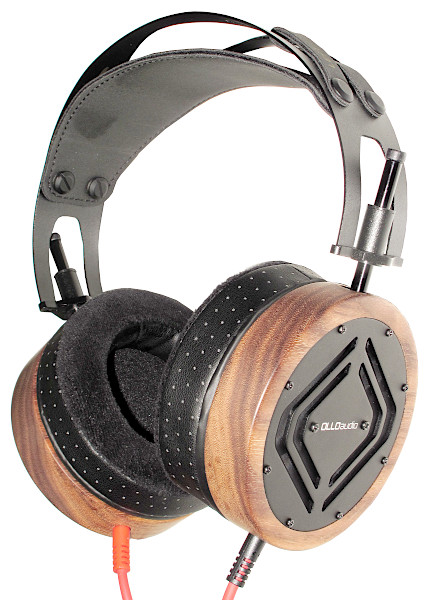
The OLLO Audio S5X (1.0) is a semi-open over-ear dynamic headphone.
It sells for € 449.- directly from the manufacturer but is also available in some web shops like Thomann.
The S5X is designed for mixing/mastering and music production.
OLLO Audio is a small Slovenian company founded in 2017 and is focused on headphones for studio usage and currently offer 3 models. Alongside the S5X also the open S4X Reference (1.2) and the closed S4R (1.2).
On top of that, materials used are very durable, metal, leather, wood. Even the packaging is all durable and made completely without plastic.
These come with a 5-year warranty.
The cups are slightly bigger, the driver is offset from the center and angled slightly, the pads differ, the driver differs (not only impedance) and now has an air-pressure equalization port.
Also the headband and connections to the cups are different.
Left side is now clearly marked on the headband.
Weighing 426 gram this isn’t one of the lightest headphones around and 30gram heavier than the S4X. Clamping force is higher than average (4.5N) but can be lowered by bending the steel headband near the cups.
The headband is made of painted steel. There is a leather strap which is not self-adjusting (like S4X/R) but fixed. Because of this there is a maximum width the cups can be pulled apart. The metal parts are microphonic when touching them but improved a bit over the S4X/R. Once on the head and seated there is no need to touch the headband so not an issue during usage.
The pads are hybrid type so different materials were used. The surface that makes contact with the skin is velour. The outer and inner side is pleather (PVC leather). The outer part is fenestrated (small holes) and the inner side is not. The pads are not angled and 28mm deep. This too is a substantial difference with the S4X/R which were 21mm deep.
The inner diameter also is a bit bigger and 56mm instead of the (rather small) 51mm diameter of the S4X/R. The foam inside is fast memory foam and feels quite firm. The pads are removable and fitted onto a metal baffle with a handy cut-out. This allows the pads to be changed easily simply by rotating them all the way around.
The cups only have a very limited swivel but can rotate 360 degrees (without a cable attached to it) and fold flat. The latter is handy for transport and lying them on a desk. The cups are made of wood and the crafting of it is very nice. It does fit well on my average sized head and can get good seal (which is important for this headphone) despite the small swivel of the cups.
There is a non-locking 2.5mm TRS socket recessed in each cup. This makes a very secure and sturdy connection.
The cups can be adjusted up and downwards over a 30mm range which should be enough to fit most heads. The adjusting is easy (not stepped) but stays in position once adjusted.
Each headphone comes with a certificate of authenticity and a measurement plot (of both cups combined) measured on a GRAS 45CC fixture acc. to IEC 60318-1 standard) and corrected to their own target.
There is also a pdf with much more measurements and comparisons made by OLLO in industry standard test fixtures. It shows measurements of S5X, S4X and S4R (and all revisions) and comparisons with a few well known headphones.
With a quite high sensitivity of 112dB/V (efficiency = 99dB/mW) and low impedance (49Ω measured) this headphone plays loud even directly from a phone. This means that it will even play loud directly from (cheaper) studio audio interfaces and instruments. There is no need for powerful amps.
The drivers are matched by the factory.
The supplied (black) cloth covered cable is 1.6m up to the cable slitter and continues as 2 separate 0.4m red smooth cables, so in total it is 2m in length. The cable is microphonic so touching the cable is audible in the headphone. The connectors come out of the cups with a small forward angle (or backward if so desired) so the cable drapes in front (or back) of the listener.
The cable is terminated in a straight gold plated 3.5mm TRS plug with a 6.3mm screw-on adapter. On the headphone side there are 2.5mm TRS plugs with red and black connectors, indicating left and right. The black connector thus goes in the cup on the side which is clearly marked on the headband with a leather strap with the ‘LEFT channel’ printed on it.
The connectors are used with a ball-lock mechanism. The connectors thus sit in there quite snugly and take some force to insert and pull out.
All in all this headphone feels and looks very sturdy and durable and is made with respect for mother nature right down to the box it ships in.
While this headphone is intended for the studio market I would say this headphone also is excellent for hi-fi music reproduction/enjoyment.
The high sensitivity/efficiency makes this headphone very suited to be driven with low output power portable sources such as phones, small DAPs, laptops, tablets for indoor music enjoyment.
Aside from some paperwork also a flat (square) soft bag is included and a key-cord that can be attached to the bag. The headphone can be stored in the travel-bag while folded flat so takes up very little height.
specifications:
Type: over ear (circum-aural), semi-open
Usage: studio, home
Driver type: dynamic
Pads: replaceable hybrid (pleather + velour) with memory foam
Collapsible: no, but folds flat
Headphone cup connector: 2x 2.5mm TRS
Cable entry: dual sided.
Cable: 2m terminated in a gold-plated 3.5mm TRS jack with screw-on 6.3mm adapter
Inner Pad dimensions: depth = 28mm, diameter = 56mm.
Driver size: 45mm (membrane diameter), angled 6°
Nom. power rating: 0.2W (estimated)
Max. voltage: 4Vrms (11Vpp)
Max. current: 125mA
Max. S.P.L.: 130dB
Impedance: 49Ω (measured)
Efficiency: 99dB @ 1mW (measured)
Sensitivity: 112dB @ 1V (measured)
Weight: 426 g. (without cable)
Clamping force: medium-high (4.5N)
Accessories: 6.3mm adapter, carrying pouch, manual, documentation.
Subjective sound description:
The good news here is these headphones sound good without any EQ needed.
Bass extension is excellent down to 10Hz (-3dB). There is a slight (3dB) emphasis between 100Hz and 600Hz. This ensures a ‘full-bodied’ sound. As can be seen in the measurements below the response between 10Hz and 3kHz is exceptionally ‘smooth’ without any dips or peaks and with a ever so slightly warmish ’tilt’. The mids thus have an excellent sound quality and sound very natural and distortion free.
The treble is slightly elevated but the response does not show any peaks or dips so is of high quality without any coarse nor sibilant but can have a (very slight) sharpness on some recordings or lead to listening fatigue with longer sessions. Easy to fix if one is bothered by it (see further below).
The upside of this small emphasis is that the sound is very detailed and airy sounding.
I am quite impressed with the sound quality of the S5X without any EQ.
Measurements:
Below the frequency response of the S5X (Left, Right)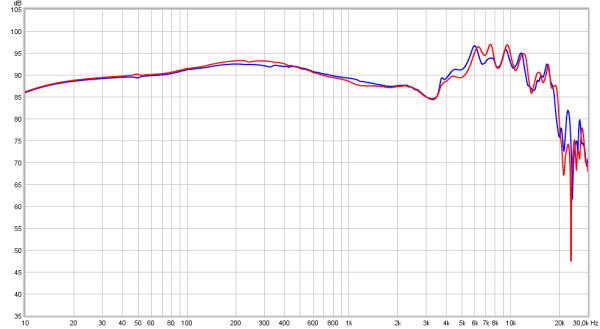
The channel matching is excellent. Bass extension is also excellent but requires a (near) perfect seal. Up to 1kHz the response is sloping downwards by 5dB giving the mids a warm/full character. Upper treble starts to roll-off above 20kHz which means it has excellent extension and ‘air’.
This is measured on a pinna-less test fixture which is known to ‘under-report’ the 1-4kHz range depending on the driver angle. The S5X has a very slight angle (about 6°) so the area between 1.5kHz and 6kHz will probably be 1 to 2dB higher than the measurements show.
compared to
Below the open S5X (1.0) versus the also open S4X (1.1) and closed S4R (1.1).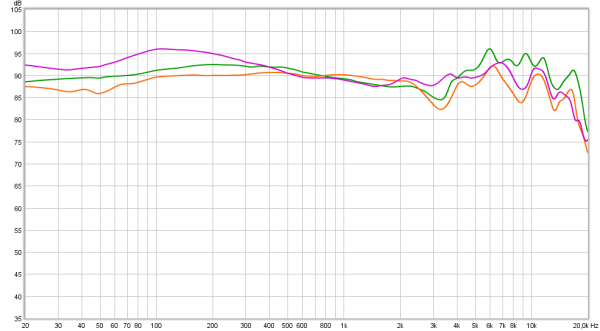 The S4X (1.1) is warmer and fuller sounding than the S5X (1.0).
The S4X (1.1) is warmer and fuller sounding than the S5X (1.0).
The closed S4R (1.1) is less warm sounding and less smooth in the treble.
The S5X thus is tonally positioned nicely in between the S4R and S4X and has a bit more but higher quality treble.
It should be noted that the S4R(1.2) has a slightly bassier tuning than the measured 1.1 version.
Below (changing every 5 sec.) a comparison with several well regarded (mostly open) headphones ranging in price from €150 up to €1000 compared to the S5X.
phase response
Below the phase response of the S5X (Left, Right) Just like the S4R/X the phase starts to change above 6kHz. As this is quite gradual without any ‘sharp’ changes in a very narrow band this is not of any audible concern.
Just like the S4R/X the phase starts to change above 6kHz. As this is quite gradual without any ‘sharp’ changes in a very narrow band this is not of any audible concern.
output resistance / damping-factor
As this is a dynamic headphone the frequency response could be amplifier output resistance dependent.
The S5X is measured via a 4 different output resistances (0.2Ω, 10Ω, 32Ω and 120Ω). On a higher output resistance amplifier the output level will be lower of course due to voltage division. To compensate for this the amplifier is cranked up to the same level (10.2dB for 120Ω at 1kHz in this case). This way the plots are overlaid and it is easier to see how the tonal balance changes. 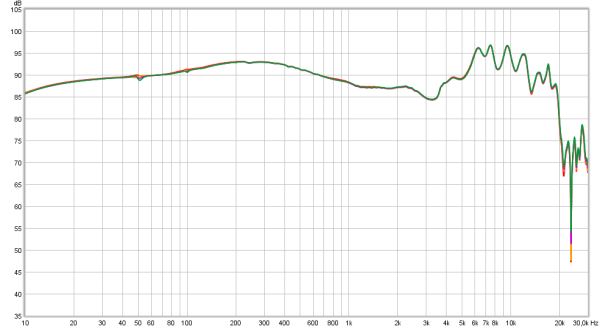 There is no tonal change when this headphone is connected to different output resistance amplifiers/outputs. This means one does not have to be worried about the ‘1/8th rule’ and this headphone will sound correct on all gear it is connected to. This means this headphone can be connected directly to all audio interfaces regardless of its output resistance and sound ‘correct’ on all of them.
There is no tonal change when this headphone is connected to different output resistance amplifiers/outputs. This means one does not have to be worried about the ‘1/8th rule’ and this headphone will sound correct on all gear it is connected to. This means this headphone can be connected directly to all audio interfaces regardless of its output resistance and sound ‘correct’ on all of them.
Linearity
While there was no reason to suspect linearity issues the S5X is measured 4 times. Once at 70dB, 80dB, 90dB and 100dB SPL. When the traces are overlaid and have the same shape then there is no compression. Note the dB scale is 2dB/div and differs from the other plots which are 5dB/division.
The plot is thus basically under a ‘magnifying’ glass.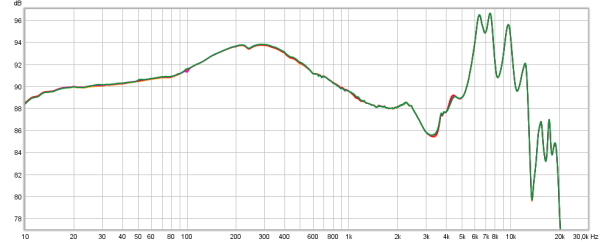
The 70dB, 80dB, 90dB and 100dB trace are all the same shape so there is no indication of compression going on till at least 97dB SPL. This means that when one plays softly or loud the headphone will always have the same tonal balance. This is excellent.
seal
Seal can be an issue with closed-back headphones and is generally less of an issue with open headphones. The open S5X is somewhat sensitive to seal issues due to the design. Because of this design the bass extension is excellent for an open headphone but only with a perfect seal.
Perfect seal, using thin armed glasses, thin armed reading glasses with arms that do not rest against the skin. thick armed reading glassed not resting against the skin.
Breaking the seal reduces bass extension. A small seal breach does not affect the response very much.
Larger seal breaches should be avoided. Something to take in consideration when wearing glasses or having much hair between the pads and the skin.
Below the distortion measurements of the S5X 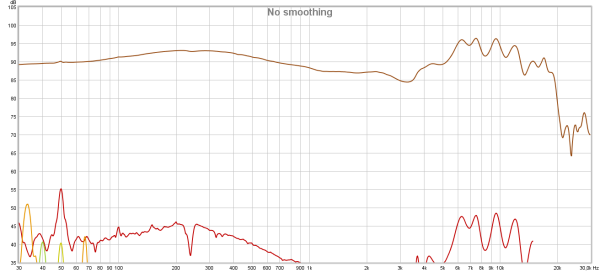 (Right channel). The measurements are made at 90 dB SPL. The plot above shows the level differences between the signal (upper trace) and the harmonics. Most people prefer to see percentages instead of level differences so below the exact same plot except ‘normalized’ to the actual signal and level differences given in percentages.
(Right channel). The measurements are made at 90 dB SPL. The plot above shows the level differences between the signal (upper trace) and the harmonics. Most people prefer to see percentages instead of level differences so below the exact same plot except ‘normalized’ to the actual signal and level differences given in percentages.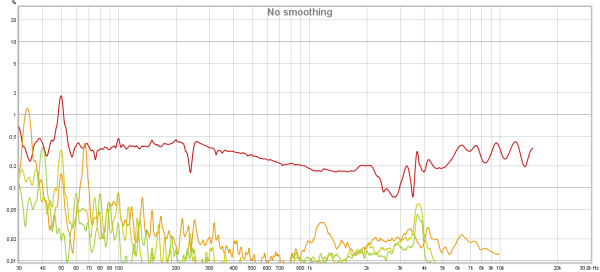 Distortion levels are very low and is exemplary and rivals that of planar headphones and closed headphones. It remains distortion free even at quite loud levels.
Distortion levels are very low and is exemplary and rivals that of planar headphones and closed headphones. It remains distortion free even at quite loud levels.
The actual 2nd harmonic distortion may well be much lower than shown. A shortcoming of my measurement rig. Also ignore the 50Hz peak (mains hum).
Below the CSD (waterfall) plot of the S5X (Left and Right are overlaid)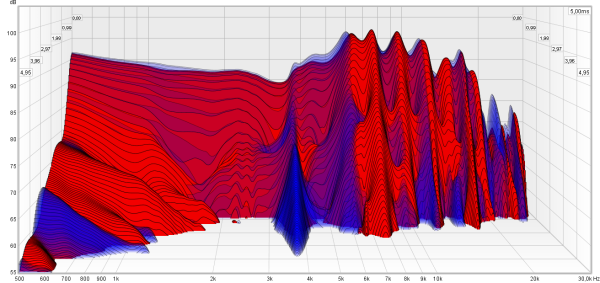 The S5X is well damped but does show some (not audible because too short to matter) resonances at 3.8kHz and 7.8kHz. As there are no longer or wide resonances visible this is also an excellent result.
The S5X is well damped but does show some (not audible because too short to matter) resonances at 3.8kHz and 7.8kHz. As there are no longer or wide resonances visible this is also an excellent result.
Below the Group Delay plot for the S5X (Left, Right)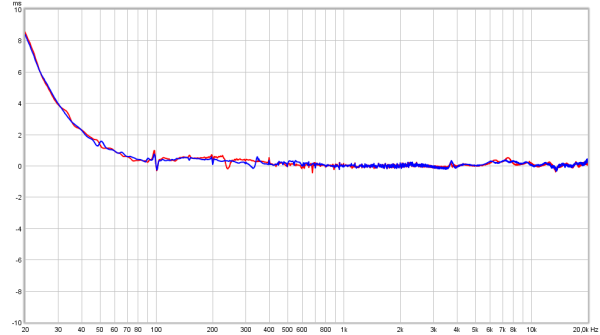 No ‘pad bounce’ and no resonances visible. Again exemplary.
No ‘pad bounce’ and no resonances visible. Again exemplary.
A different plot is the spectrum plot. This basically is a CSD (Waterfall) plot but viewed from above where the level differences are color coded instead of being in the vertical axis. Also the frequency range of the spectrum plot is wider (from 100Hz instead of 500Hz). The time span is also bigger in the spectrum plots and expired time is shown from below to top where in the CSD the time is shown from rear to front.
Below the spectrum plot of the S5X (Left channel)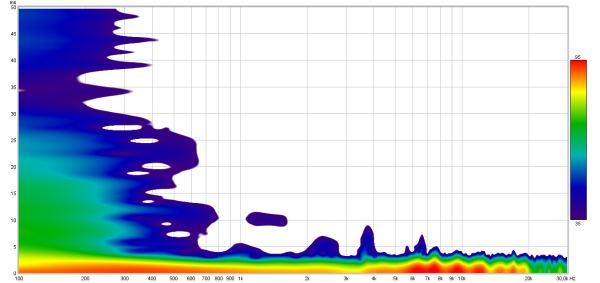 No alarming resonances or lingering is visible. Bass response is also well damped.
No alarming resonances or lingering is visible. Bass response is also well damped.
Step response
Below the step response plot which, when the sound is balanced and well extended should show a fast rise to around 0dB, (indicating fast driver response) and then should be slightly sloping downwards indicating bass extension. (Left, Right)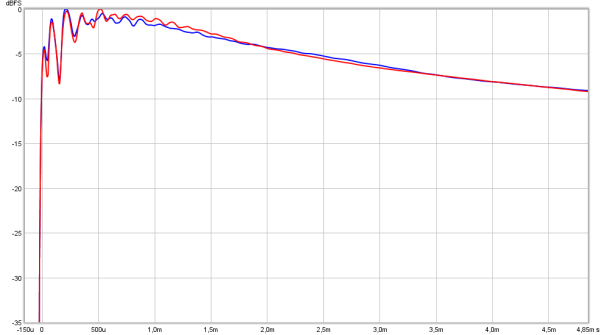
The sharp rise up to -5dB below the reached peak level indicates the driver response is well damped. There is no overshoot. The 2 peaks in the first 250μs show there is a bit excess treble around 7kHz which indicates clarity is just a bit higher than desirable for music enjoyment but fine for mixing as it highlights possible sharpness issues in a recording. The horizontal trace barely sags after 1ms indicating excellent sub-bass extension.
positioning consistency
Below a plot showing 3 ‘re-seatings’ on the test fixture in a similar way as one would put them on the head (by feeling if it is in the correct position). As can be seen the tonal response is not changing when put on the head a number of times with not too big positional differences.
As can be seen the tonal response is not changing when put on the head a number of times with not too big positional differences.
cross-talk
Another measurement which shows the acoustical cross-talk. Cross-talk is the level difference between signals of the left side entering into the right ear (and vice versa).
In this measurement the left driver is making sound and that sound that is picked up by the right microphone (right driver is not connected/driven) is measured (psycho-acoustic smoothing applied). This sound is transmitted through the air, headband (unlikely). Sound transmission of the test fixture is not included as during the test the left driver is not coupled to the test fixture.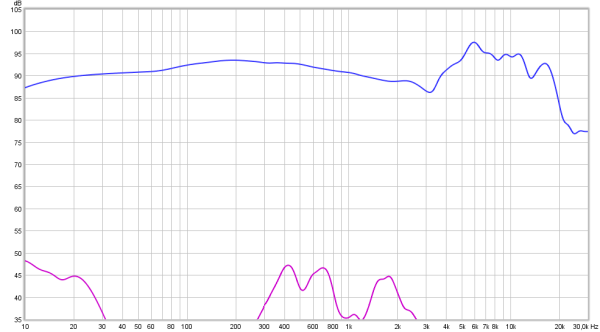 This shows that the cross-talk is ‘worst’ between 300Hz and 2kHz and around -45dB.
This shows that the cross-talk is ‘worst’ between 300Hz and 2kHz and around -45dB.
When this would be represented as a percentage it would be 0.5%. So, again nothing to worry about.
The rise in the lowest frequencies is background noise present in the room.
There is no electrical cross-talk as the cable has 4 conductors and the return wires are connected in the 3.5mm plug.
Drivers
Below a picture of rear side of the S5X earpiece (the metal plate + dust filter removed). The S5X driver is based on the same chassis that were used in the S4R/S4X. But it is not the exact same driver. The voice-coil of the S5X is 50Ω instead of 32Ω (S4X/R) and the damping of the S4X is different (less damped in the S5X) as well. Most likely the changes are not only the voice-coil resistance and damping as the driver membrane seems to behave better.
The S5X driver is based on the same chassis that were used in the S4R/S4X. But it is not the exact same driver. The voice-coil of the S5X is 50Ω instead of 32Ω (S4X/R) and the damping of the S4X is different (less damped in the S5X) as well. Most likely the changes are not only the voice-coil resistance and damping as the driver membrane seems to behave better.
Also the pads differ.
Below the S5X with original pads and when fitted with the S4X pads.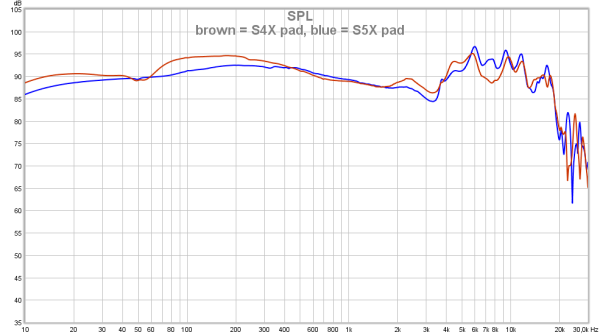 The pads of the S5X are ‘better’ than those used for the S4X. The outer (and inner) diameter of the S4X pads is smaller than that of the S5X so one could fit the S5X pads on the S4X and get a better tonal balance but the pads would sit a bit sloppy on the S4X.
The pads of the S5X are ‘better’ than those used for the S4X. The outer (and inner) diameter of the S4X pads is smaller than that of the S5X so one could fit the S5X pads on the S4X and get a better tonal balance but the pads would sit a bit sloppy on the S4X.
Aside from the pads being different also the driver itself is positioned a bit offset towards the front of the headphone and angled a tiny bit (just 6°) and the driver is not partly covered (holes in the baffle) as with the S4X and S4R.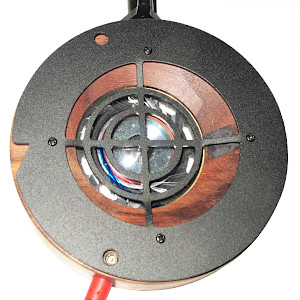 Because of this the sound also is a bit different. To me the stereo imaging/head-stage did not improve much compared to the S4X/R but the sound quality of the S5X certainly is improved a bit.
Because of this the sound also is a bit different. To me the stereo imaging/head-stage did not improve much compared to the S4X/R but the sound quality of the S5X certainly is improved a bit.
The driver itself is protected from dust by a dust filter that is integrated in the pads.
The pads also differ from the ones used in the S4X/R. The pads are 7mm thicker (deeper), 28mm instead of the 21mm of the S4X/R. The inner diameter also is 5mm wider, 56mm instead of the 51mm of the S4X/R. Comfort, because of this is also improved.
Treble
For mixing mastering a small emphasis in the treble (not peaks but an overall ‘boost’) can show (potential) problems in a recording so a bit elevated treble is a blessing in such circumstances.
It will result in smoother sounding ‘end product’.
For high fidelity sound reproduction (so listening to music for pleasure) a small emphasis can lead to ‘sharpness’ and even listening fatigue. Upside is that the music sounds ‘more detailed’ because of this.
For listening to classical this small emphasis is not a problem, even desirable. For popular music it can be less ideal. A solution is EQ or adding a small piece of 1mm felt from a crafts store.
Take off the pads. Cut a round piece from the felt which fits in the middle part. Put the pads back on.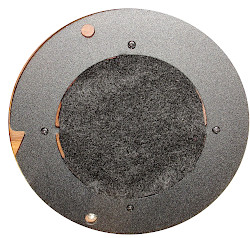 This lowers the treble just enough as can be seen in the plot below. (stock, with felt)
This lowers the treble just enough as can be seen in the plot below. (stock, with felt)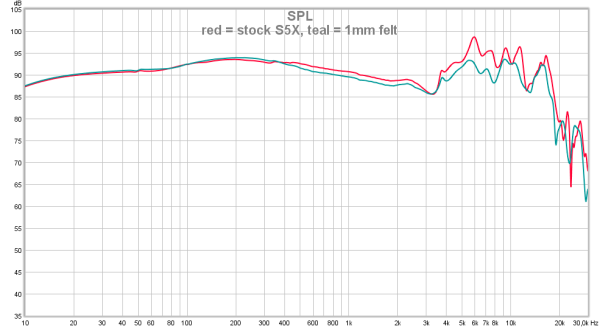
conclusion
The OLLO Audio S5X is not ‘just another headphone’ on the professional market. While this headphone is intended for the professional market specifically for mixing, mastering and playback the applicability goes beyond that specific goal only. At € 449.- this isn’t a cheap headphone but offers sound quality competing and exceeding that of many much more expensive headphones, both in the professional and ‘hi-fi’ range. It is a step up from the S4X in both comfort and sound quality.
Those looking for thumping bass should either look elsewhere or use EQ (reacts great).
This headphone sound excellent directly out of the box (without EQ !). Because of this it is easy to use when evaluating a recording without having to use EQ presets. Just plug it in any device.
For music enjoyment the treble is a tad too much in level. The treble quality is quite good though.
A little bit of EQ or the felt makes the S5X a good sounding headphone of excellent build quality and, not unimportant, with great support and availability of all parts in the future.
This headphone does not get ‘shouty’ at louder levels which is a very good thing.
The high clamping force, high-ish weight and limited tilt of the cups is something to consider.
The high sensitivity/efficiency makes this headphone very suited to be driven with low output power portable sources such as audio interfaces in (home) studios, instruments, phones, small DAPs, laptops, tablets. Due to the open character only suited for indoor usage.
- Those that want accurate sound (akin to the tonal balance of speakers in a room) but need to use a headphone should consider the S5X.
- It is an open headphone so outside noises are not attenuated much and others around you can hear what is playing.
- The OLLO headphones are very serviceable and of durable quality materials such as steel and wood.
- Every part can be ordered if needed so very serviceable and maintainable.
- The manufacturer is very approachable and even offers a trial arrangement, a nice carrying case and it appears an amplifier is even in the making.
- The build quality is excellent and has got the sound quality to match.
- The cups can lay flat on the desk.
- The S5X has a high sensitivity thus can play loud (with authority) from almost every device. Be careful with the volume control. It plays loud quite quickly.
- Completely insensitive to output resistances of sources so no need to worry about the sound quality degrading on some sources.
- Replaceable cable.
- 5 year (limited) warranty.
- Accurate individual frequency response measurement of each headphone provided in the box
- Sustainable materials used even for the box it comes in.
- 30-day trial period
- Hand matched (measured) drivers.
- Excellent sound quality with distortion free sound even at loud levels.
Of course there are also some niggles.
- The headband is microphonic (tapping it is audible).
As long as you don’t touch it its fine though. - The treble is a bit accentuated and could lead to listening fatigue with longer listening sessions. EQ or the felt modification described above helps greatly.
- The clamping force out of the box is high (4.5N). After half an hour I got a headache and lowered the clamping force by carefully and strategically bending the metal headband (to 3N).
- The inner diameter of the pads is still a bit on the small side (Ø 56 mm) for people with large ears but has enough depth (27 mm).
- The cable is microphonic, touching it is audible in the cups, even with music playing.
- There is very little tilt adjust-ability so for wider heads it may be difficult to get a good fit/seal. Seal is quite important for this headphone when bass extension is important.
- The S5X has a fair bit of weight to it, mostly because of the usage of sturdy (not plastic !) materials.
- The headband padding limits the maximum stretch of the headphone. People with larger heads may have to stretch the headphone forcefully when they want to put it on easily.

“There is a slight (3dB) emphasis between 100Hz and 600Hz”
Looking at your graphs and comparing them to the manufacturer graphs using two different IEC compliant measuring devices, it would appear your measuring system is probably responsible for at least half that emphasis, and your results are skewed across multiple headphones pretty consistently in that regard. Unless you had an included FR trace included in the box that backed up your results, you might want to use whatever results they included in the box to actually improve the compensation of your measurement system.
As can be seen on all targets for industry standard fixtures the curves drop in that area.
I am using my own target and my fixture does not adhere to any standards either.
The moment I start compensating that I would have to redo all plots and all comparisons. It is the ‘Tyll’ problem basically where Tyll decided not to revisit all measurements he ever did.
So yes, my measurements are not exact but so aren’t other measurements.
One thing they are good for is comparisons as all measurements are similarly made.
The lack of pinna can cause some differences between 1kHz and 5kHz anyway depending on driver angle and distance.
impressive, I don’t think I have ever seen you give another headphone such high praise. Seeing how it matches the DT1999 analytical in the mid bass and lower mid-range it would seem that the bump in the aforementioned area is in reality a literal linear response, right? if I understand correctly your own target is not quite alike to Hartman but still has the 200hz dip, even though the bass is not boosted enough to require the dip in order to avoid mudiness. please correct me if I am wrong. for a couple months I have been considering getting the DT1990 after being pleased by a short test of the DT880, but now these cans show up with a seemingly very similar tuning except by the treble. if you don’t mind could you please tell me your opinion of these vs the DT1990 with EQ or filter?
My own preference differs slightly from Harman. To me Harman target has a bit too much lower bass.
The DT1990 (with filter/EQ) is an upgrade over the DT880. Do note that ‘DT880’ does not really exist, there are several different DT880’s ranging from very bassy to bass-shy versions.
DT1990 is quite comfortable and has a good sound quality.
The S5X has better bass extension and does not need EQ. Comfort on the Beyer is better. Personally I prefer the S5X as it is easier to drive and does not need EQ.
With a little bending of the headband it is possible to get a good fit (required for bass extension) and comfort.
The DT1990 will be comfortable as is and with the filter and A-pads is also an excellent choice in this price range.
Very interesting and informative review. Thank you!
I was wondering if you have any comment about the difference with the S4X. Specifically, regarding the stringer treble of the S5X.
With the S5X, I fear a little bit of ear fatigue DT770-style.
There is no stinger treble in the S5X.
The S4X is warmer and a bit boomy. I would take the S5X over the S4X if I had the money. Note the current 1.2/1.3 is tuned a bit closer to the S5X.
Hi Solderdude
Thank you for your answer!
(Apologies. I just noticed the typo: “stinger” should have been “stronger”!)
Your comments regarding S4X vs S5X are very interesting. It looks like you have a strong preference towards the S5X.
I guess that if one finds the S5X’s high frequencies too intense, the felt trick can help.
The felt is not desirable for mixing (just like the HD490PRO also has elevated treble with the mixing pads) but it is a bit too much for music enjoyment.
The felt trick is easy to do, reversible (can be taken out again) and makes it a hifi headphone.
I am told that the current S5X has less elevated treble but have had no confirmation from OLLO about a change but also no denial either (I asked).
Not everyone is bothered by some extra treble b.t.w. as long as it isn’t peaky, which the S5X isn’t.
I prefer the S5X over S4X (even when EQ’ed to the same target) because of the comfort and construction improvements.
OLLO still needs to improve the headband and cup construction a bit further (IMO).
Hi there. So, how about a piece of tissue? I’ve seen that trick done. Would that have an impact on taming the highs?
It depends on what paper is used. Not all tissue paper and toilet paper is created equal in density.
So yes, it can be used and one can play with layers/plies. The downside of paper is that it can easily tear.
Not so with felt.
Gotcha. Thanks!